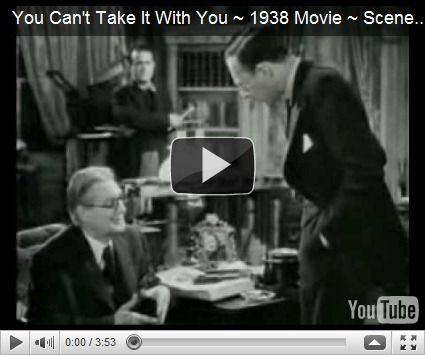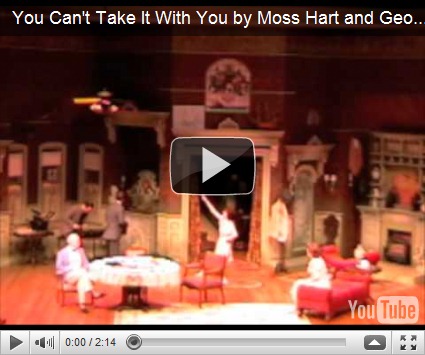I feel bad that I haven’t been around blogging much lately but I’ve been just slammed in my personal life with things that take away my blogging time. Hopefully October will be better.
On Thursday, in the midst of a very busy day, I saw that the progressive blogosphere was talking about the idea of giving U.S. taxpayers a receipt for their taxes that shows how their tax money is being spent. I didn’t really have time to read all the commentary but I thought it wasn’t a bad idea if it could actually be done (and I had my doubts about that). On the other hand I didn’t really think it would make any difference because Americans are now trained to think that taxes are a bad thing. In my experience, presenting people with facts doesn’t really change most people’s mind. People hear what they want to hear and believe what they are trained to believe.
That same night I went to the production by The Repertory Theatre of St. Louis of You Can’t Take it With You, the comedy classic by George S. Kaufmann and Moss Hart. I’ve seen it many times but I hadn’t seen it in a number of years. (And may I say that this production is the best I’ve ever seen and, if you can catch a performance before it closes, you should see it.)
One of the subplots of the play involves a visit to Grandpa Vanderhof by an Internal Revenue Service Agent named Mr. Henderson who is trying to collect years of back taxes owed by Grandpa. Grandpa was once a successful businessman but one day (apparently years before the play began) he realized that he wasn’t happy so he simply stopped working. Now he catches snakes and watches college commencement exercises and only does what he wants to do. He doesn’t want to pay income tax. This results in a classic scene between Grandpa and Mr. Henderson:
Grandpa: Suppose I pay you this money-mind you, I don't say I'm going to do it-but just for the sake of argument-what's the Government going to do with it?
Henderson: What do you mean?
Grandpa: Well, what do I get for my money? If I go into Macy's and buy something, there it is-I see it. What's the Government give me?
Henderson: Why, the Government gives you everything. It protects you.
Grandpa: What from?
Henderson: Well-invasion. Foreigners that might come over here and take everything you've got.
Grandpa: Oh I don't think they're goin to do that.
Henderson: If you didn't pay an income tax, they would. How do you think the Government keeps up the Army and Navy? All those battleships...
Grandpa: Last time we used battleships was in the Spanish-American War, and what did we get out of it? Cuba-and we gave it back. I wouldn't mind paying if it were something sensible.
Now I’ve seen this play many times and I’ve seen the movie multiple times and each time the audience relates to Grandpa but also realizes that he is eccentric. The very fact that Grandpa is saying this to the IRS agent makes him eccentric.
But how times have changed. Whereas in past productions the audience has laughed through the Mr. Henderson scene, at the production on Thursday night the audience roared with laughter. They laughed so hard it was hard to hear the dialog. I was slightly bothered by that reaction. And I found myself wondering why this time the reaction to the play was different.
For those of you who either have never seen You Can’t Take it With You or need a refresher, it is the story of an extended family who all live in a big old house with Grandpa Vanderhof. They are, to put it very nicely, eccentric. But they are very supportive of each other and of other people in the world who might otherwise be written off as not worth the effort. They are a loveable bunch. The most normal is Alice, one of Grandpa’s granddaughters, who is the only character to work outside the home. She works as a secretary on Wall Street and the dramatic tension of the story results when she begins to date the boss’s son, Tony, and is required to have the boss, his wife and Tony over for dinner. Although she loves her family she foresees difficulties ahead. Tony assures her that all families have their eccentricities. After all, he says, his mother believes in spiritualism. But Alice says:
Your mother believes in spiritualism because it’s fashionable. And your father raises orchids because he can afford to.
My mother writes plays because eight years ago a typewriter was delivered here by accident.
Alice’s sister Essie, who has a home business making and selling candy, took up ballet at about the same time Alice’s mother began writing plays. She is not a good dancer, to say the least, but she flits endlessly around the house practicing and no one seems to mind. Essie’s husband Ed plays the xylophone while Essie dances and delivers her candy for her. He is enamored of a printing press and loves to find interesting sayings to typeset and print off. Alice’s father spends his time in the basement designing fireworks with Mr. De Pinna, the iceman who came one day and never left. Explosions rock the house at all hours. The family does have “help” in the form of Rheba, the black maid, and her boyfriend Donald who is “on relief” and who both seem like part of the family. And Essie’s Russian ballet teacher, Kohlenkov, is there more often than he is not.
One of the great things about the Rep’s production is that Amelia McClain, who plays Alice, invests her with a sort of hyperactivity that makes the audience believe she really is a part of this eccentric family. Too often Alice is played in a way that makes her seem so different from the family that the audience begins to believe that a mistake was made at the hospital and her mother brought home the wrong child. It’s often hard to take Alice seriously when she says that she really loves her family. But Amelia McClain makes this easy for us to believe. Her performance balances perfectly with Joneal Joplin’s interpretation of Grandpa Vanderhof. Joplin plays the character perfectly straight and not for laughs. One can see how sensible Alice, with only a slight change in life direction, could have become Grandpa. Or how Grandpa with only a slight change could have been Alice. And the rest of the cast invests the zany characters with real depth so that they feel like people you might very well meet and not mind being around, eccentric though they are. Jamie LaVerdiere’s portrayal of Ed, the husband of Alice’s sister Essie, may be the best portrayal of that character I’ve ever seen. He invests Ed with a sweetness that is often missing. And rather than make Ed a bumbling nincompoop on the xylophone, he actually plays well and seems to have fun doing it.
By the time Mr. Henderson arrives the audience has completely bought into the idea that the whole household is zany so the fact that the IRS Agent leaves without making any headway in his seemingly reasonable explanations about why Grandpa should be paying income taxes is just part of the fun. But, as I said, in the production I saw on Thursday the audience roared with laughter and most of it wasn’t laughing along with Grandpa it was laughing at Mr. Henderson. Yes, I live here in the midst of Red State Missouri with lots of crazies who don’t want to pay any taxes and don’t seem to care that Missouri’s bridges are all in danger of falling down. (Go see the movie Winter’s Bone if you want to understand how I feel about my state). But audiences at the Rep tend to be a bit more liberal than the average Missourian. So what accounted for my discomfort at the scene and the reaction to it?
I went to youtube and found video of the movie version of the scene. This isn’t completely helpful because for the movie they rewrote the script so that different portions of the act were taking place all at the same time. It is a good way to create the slightly off balance and zany aspect of the household. Tony is, in fact, visiting and his incredulous chuckle when Grandpa says that he doesn’t believe in the income tax is really a stand-in for the audience reaction. (Jimmy Stewart plays Tony in the film). Here it is. You’ll see that the whole household is sort of “off” and while the IRS Agent isn’t likeable he is portrayed as maybe the sanest one in the room other than Tony. A bully, but sane.
My recollection of versions of the play that I’ve seen is that the reaction is the same. Now, in the play, Tony isn’t present for the scene but that’s ok because there is a live audience to chuckle. The IRS Agent is generally played as a typical bullying bureaucrat but the audience recognizes that he is trying to do his job and is astounded at this not-very-normal family he has found. So the laughter is at the fact that a bullying bureaucrat can’t get his way but also an acknowledgement that he has come up against a family that isn’t “quite right”.
Steven Woolf’s direction of this scene at The Rep was interesting. Mr. Henderson enters into a household enmeshed in their typical chaos but as he begins to speak to Grandpa the entire onstage cast (the mother, Essie and Ed) move to chairs and sit quietly like perfectly normal people listening to this encounter and Joneal Joplin as Grandpa plays the scene calmly, almost indifferently. He sees Mr. Henderson as a bit of entertainment to liven up an otherwise normal day. He doesn’t get aggressive at all with the IRS agent and doesn’t overtly bait him, he just states his point and asks questions in a rational tone of voice. And as the scene goes on it is the character of Mr. Henderson who begins to act slightly unhinged as he can’t believe he is having this conversation. It is only at the end as he is shouting at Grandpa about sending him to jail that Ed and Essie begin to act their wacky selves and yet Ed is playing a Sousa march and Essie is marching in mock patriotic way and the staging makes it seem that they aren't so much eccentric as they are a backdrop for Mr. Henderson’s out of control tirade and somehow they make him look like the crazy one.
And as the audience roared through this scene I think what was making me uncomfortable is that this is a completely accurate portrayal of how all conversations go these days in my state. There is no doubt in many people’s minds that they are correct and they shouldn’t have to pay any tax – NOT because they are rebels but because they are the sane ones and the people who believe in taxes are the insane ones. There isn’t any sense in even fighting about it, their demeanor says. If you think taxes are good then there is something wrong with you and we’re sorry for you. And there is a sense that no matter how many facts one might pull from one’s head, it isn’t going to change their minds. And the infuriating thing is that they aren’t evil people. They are people that you otherwise like. They are people you might be related to. Whereas Kaufmann and Hart created an eccentric family that might stymie Mr. Henderson because he hasn’t encountered anything like them before, in 2010 they are the norm here in Missouri.
I don’t think a tax receipt would have convinced Grandpa Vanderhof. And in the end he would still have felt no compunction about committing tax fraud in order to avoid paying his income tax (sorry for the spoiler but I won’t tell you how he does it). And most people around here would applaud him.
Fortunately you don’t have to take my word on the staging for this scene because the Rep has put the end of the “Mr. Henderson” scene on Youtube as part of their advertisement. Compare it to the movie version. I don’t know when it was filmed but imagine a performance where the audience laughter is nonstop and so loud you almost can’t hear the dialog – as you watch the scene you will realize that type of laughter is far out of proportion to what is going on in the scene. If you can imagine that you can imagine my experience on Thursday.



